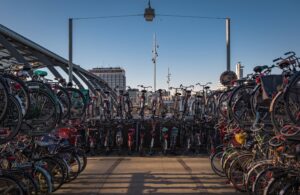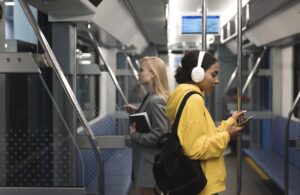The Netherlands offers an efficient public transportation system, including trains, trams, buses, and metros. The system is a boon for job seekers, providing the flexibility to explore career opportunities across the Netherlands. The Dutch public transport system supports your career journey every step of the way, making it simpler to connect with potential employers and broaden your professional horizons. Let’s have a look at what you need to know to get around!
Dutch cycling culture
The Netherlands is famous for its cycling culture. Bicycles are a popular mode of transportation for daily commutes, with well-developed cycling infrastructure throughout the country. Most of the larger train stations in the Netherlands allow you to rent an OV bike for a daily fee for additional freedom of mobility.

Public transportation
Arriving in the Netherlands and attempting to navigate the extensive public transportation system could leave some a bit confused. Below, we have listed some of the basics to help you better understand what awaits you.
OV-chipkaart or contactless payment
The OV-chipkaart is an integrated ticketing system that plays a significant role in the public transportation system of the Netherlands. It is a contactless smart card that allows passengers to use various modes of transport, including trains, trams, buses, and metros, with a single card. You can order it online or buy it at an OV service station. As of recently, you can check in and out of every mode of public transportation with contactless payment, such as a debit card or credit card.
Train travel
An important thing to look out for when travelling by train in the Netherlands is that there are different types of trains, depending on the number of stops they make and their speed.
- The Sprinter train stops more frequently and allows you to exit at local train stations within cities. For instance, Amsterdam has 8 train stations that can be accessed with different Sprinters; therefore, make sure you get on the correct type of train.
- The Intercity train is a faster option that covers more distance and only stops at major train stations, like central stations in each city. Due to the number of people taking this train daily, they are double-decked and also offer 1st class travel for an additional fee. Intercities are ideal for comfortable long-distance travel throughout the Netherlands.
- The Intercity Direct train operates on a high-speed railway between Amsterdam and Rotterdam and connects North and South Holland. It is the fastest train, making fewer stops than the Intercity, and runs multiple times per day. Remember that you need to pay extra to use this train; you can do so online, or by tapping your OV card or contactless payment at one of the check-in columns on the platform.

Local public transportation
Locally, you can make use of metro systems, tram, and bus connections to get to your destination.
- Buses operate overground and serve both urban and rural areas, filling in where trains do not reach.
- Metros mostly operate in Amsterdam and Rotterdam and are a quick way to get around the cities.
- Trams are ideal for navigating short distances within a city.
Useful websites for public transportation in the Netherlands
9292 is an online platform and mobile app that provides public transportation information and planning services for the entire country. It offers real-time travel advice, including routes, schedules, fares, and alternative options for trains, trams, buses, and metros. Users can enter their origin and destination to receive detailed travel itineraries, including walking directions, transfers, and estimated travel times.
NS is the national railway company of the Netherlands and operates the majority of train services. Their website provides information about train schedules, ticket prices, and special offers. Disturbances to the public transportation system due to accidents or weather will be displayed on the homepage of NS as soon as possible.
GVB is the public transport company for Amsterdam and operates the city’s trams, buses, and metros. It also provides useful information for tourists and newcomers, including travel tips, maps, and information on purchasing and using the OV-chipkaart.
RET is the public transport company for the Rotterdam region and operates trams, buses, and metros in the area. Their website provides information on routes, schedules, ticket prices, and service updates specifically for Rotterdam and its surrounding areas. It also offers travel tips and a journey planner tool to assist users in planning their trips.
HTM is the public transport company for The Hague and operates trams and buses in the city. Their website offers information on routes, schedules, ticket options, and service updates specifically for The Hague. It also provides travel advice, maps, and details about special services and facilities for different user groups, including tourists, students, and commuters.

Navigating the Netherlands’ public transportation system offers job seekers an invaluable asset in their quest for employment across the country. Whether it’s the efficiency of the train services or the convenience of local trams and buses commuting is made stress-free. For those looking to make their mark in the Dutch job market, understanding and leveraging the public transportation network can significantly ease the transition, ensuring that no opportunity is beyond reach.
Are you ready to take your next career step in the Netherlands?






